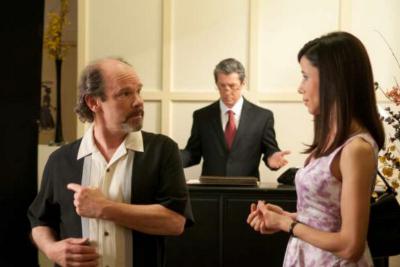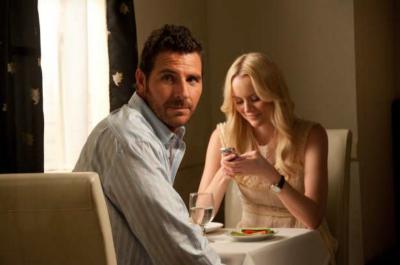By: debbie lynn elias
Audrey Lewis is the average single woman. She dates a guy once, twice rarely rolls around and thrice, well, a blue moon happens more often. She is a week away from turning 34 but claims to be 29. And she’s single. She has every neuroses about life one can possibly think of as an insecure single woman and her fertile imagination and the requisite “always thinking the worst” causes unwarranted and unnecessary problems in her life. (And did I mention that she’s single?) She over-thinks and over-talks everything. And yes, despite her talent and skill as an architect, she is very insecure about that, too, which could explain why her boss continually relegates her to designing parking garages. Audrey may think big and dream big but thanks to her own imagination and insecurities, she remains a timid wallflower, too shy to be bold, too shy to take a stand, “content” to accept her self-perceived shortcomings. And yes, she is single. But it’s these insecurities and Audrey Lewis’ “worst case scenario defeatist attitude” that provide the humor and the heart in the quirky and adorable AUDREY.

Having just broken up aka dumped, by the arrogant, egomaniacal and chauvinistic Pete, Audrey is desperate to find a man, and a husband. After all isn’t that what she’s supposed to do, what her mother told her to do? One of Audrey’s greatest fears is that she will end up alone. She may have a good career, but she will be alone. But there is a light at the end of the tunnel thanks to local newspaper stand owner Walt. Almost a fairy godfather, Walt introduces Audrey to Gene. In Audrey’s mind, Gene is her Prince Charming to her Cinderella, but what does Gene think? As they make it past date one, AND date two, the unthinkable happens. Gene invites Audrey to brunch at a local French bistro. It’s Date Three!!!
As the big day arrives, Audrey is pulling out all the stops; buying the perfect new little dress, matching shoes, perfect hand bag, practices her posture, stance and hand folding, and the morning of the brunch, does the unimaginable – she gets a full make-over at the local Sephora store. In Audrey’s mind, she is now the picture perfect imitation of perhaps a more famous “Audrey”. Confident, pretty, she’s ready for her date.
Arriving at the bistro early, after waiting 15 minutes, Audrey’s insecurities take hold. She is thrown off guard by the rather snotty maitre d’ who dislikes “a party of one” taking up a table or even being shown to the table to wait. As the minutes tick by, Audrey starts going into a freefall. All she sees on the menu are calories, not the food items; the butter knife becomes her best friend as she checks her teeth for lipstick, not to mention spying on her ex-Pete who has arrived with his new girlfriend Tess; and what about that couple at the next table who are whispering? It has to be about her, right?; and, oh where is he? Let me call his cell phone and see if he answers but then hang up. Giving up on Gene and trying to make an escape unseen, her boss arrives with the VIP client for whom Audrey is designing a parking garage. So much for leaving now.
Forced to stay and face the inevitable humiliation of being stood up, the experience is only furthered by a precocious little girl named Rose, not to mention a rather gregarious yet sweetly intentioned balding man in a bowling shirt named Donny who keeps trying to buy Audrey drinks with little umbrellas in them. And then there’s the busboy, Juan. How will Audrey ever get through this disaster of a day?

Sybil Darrow is nothing short of quirky adorbsome as AUDREY. The camera loves her. Darrow brings a freshness to AUDREY that keeps the character likeable even while drowning in self-pity and imagined tragedy. She gives AUDREY the beautiful frailty of a wilting flower that perks up from a ray of sunshine. Lovely performance and character nuance.
As the chauvinistic Pete, Ed Quinn is spot on. Narcissistic, braggadocios, Quinn hits all the beats but then amps it up during the imagined fantasy sequences. It works. wilting flower. Jonathan Chase is beyond boy-next-door charming. With a smile to melt the coldest heart and an affability that is engaging and infectious, it’s a shame that AUDREY is premised on Gene’s absence as Chase is a joy to watch. His chemistry with Darrow is palpable and enjoyable.
Adding some weighty wisdom to the experience are veterans Ed Asner, Charles Shaughnessy and Ethan Phillips. Although too brief in his appearances, Asner enchants as the kindly, grandfatherly Walt. Shaughnessy on the other hand, is a haughty delight as maitre d’ Jacques, capitalizing on the limited, but noticeable arc of the character. Real fun comes compliments of Ethan Phillips who steals scenes as the seemingly pesky but kind-hearted Donny. Phillips – and the dialogue – play to his being more of a court jester in appearance than a Prince Charming, but in the “can’t judge a book by it’s cover” category, provides some needed subtext.

Co-written by Dean Pollack and Sybil Darrow with Pollack directing Darrow as AUDREY, the film capitalizes on the stereotypical cliches and tropes of female insecurity, using that as the stepping stone for some fun fantasy moments and the rather whimsical humor that fills the film. While most women may not openly admit that their own minds have reeled with some of the same thoughts and fears of AUDREY when it comes to being single and the dating landscape, trust me, at some point in lives we all have. And it’s that touchstone that resonates; especially when we’re all still standing, surviving and thriving. There is that unspoken light at the end of the tunnel for AUDREY that the audience sees before she does. It’s a tricky emotional narrative to walk, but Pollack and Darrow navigate it cleanly.
Structuring the one hour in the restaurant to play as real-time is not an easy task, yet thanks to the construct of AUDREY and her flashbacks and fantasy sequences with various patrons in the bistro, the story moves and expands from what could have been a flat cold canvas. A mix of hand-held, dolly and steadi-cam work, travelling from table to table, around people, a trek to the bathroom, buttressed by a wide range of angles effectively moves the audience in and out of patron POVs and the metaphoric relation to AUDREY’s perceptions. Cinematographer Pierluigi “Gigi” Malavasi also uses light as a beautiful storytelling tool creating some lovely imagery. Color saturation just fuels the fantasy and Audrey’s imagination even further, enriching the palette. A particularly effective scene that showcases Malavasi’s visuals is between Donny and AUDREY. Engaged in a very heartfelt conversation with pearls of wisdom and kindness from Donny, the ambient light begins to change and the third act opens up with a brighter, clearer light while the camera captures a rosier, more saturated glow on AUDREY’s skin and a sparkle in the eyes that one can’t help but notice.

Thanks to production designer Mona Nahm, small details like silverware, cell phones, plating of food, table layout, color usage are meticulously employed, adding texture and eye appeal for Malavasi’s work. And a big shoutout to costumer Bonnie Stauch who found the picture perfect simple cotton dress sprinkled with lavender flowers that AUDREY wears in the restaurant. So metaphoric of the idealized 1950’s Barbie perfection.
Peter Golub’s score captures the lilt and whimsy of AUDREY and her foibles and is a delight.
But folks, stay through the credits. Both the main and end title sequences are designed by Scott Lipe who charms with whimsical crayon-esque drawings which are part of the story, especially the end title with provides us with an epilogue.
Rooted in an unspoken honesty, serving as a wonderful mirror into each of our heads, done with laughter, smiles and self-panic, AUDREY is adorable.
Directed by Dean Pollack
Written by Dean Pollack, Sybil Darrow
Cast: Sybil Darrow, Ed Quinn, Jonathan Chase, Charles Shaughnessy, Ed Asner












